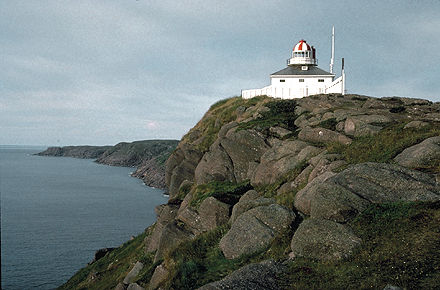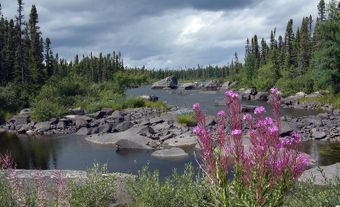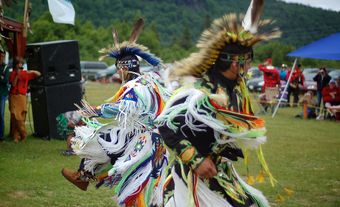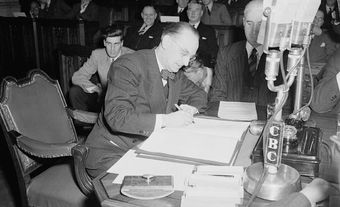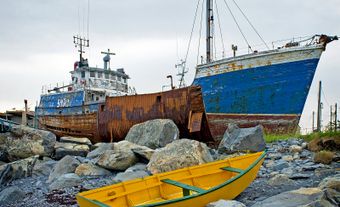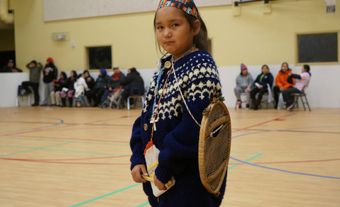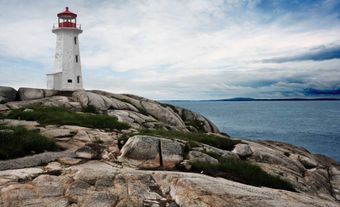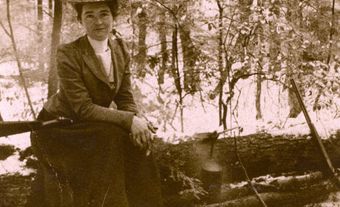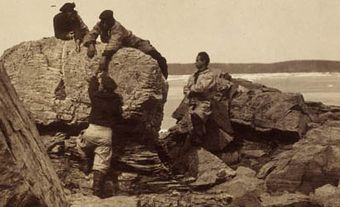Newfoundland, the youngest of the Canadian provinces, joined the Confederation in 1949. Some portion of its coast was undoubtedly one of the first parts of the continent seen by Europeans. Its total area is 405,720 km2, of which Labrador makes up almost three-quarters (294,330 km2). The island of Newfoundland is the easternmost region of Canada, while Labrador is located on the mainland to the northwest. Since John Cabot's arrival on the “new isle” the island has been referred to as Terra Nova, or in English, Newfoundland. Labrador probably received its name from the Portuguese designation, "Terra del Lavradors."
Geography
Newfoundland and Labrador is divided by three of Canada’s seven physiographic regions. These three regions are the Canadian Shield in Labrador, and the Appalachian and Eastern St. Lawrence Lowlands on the island of Newfoundland.
Labrador’s northern coastal region is mountainous, deeply fjorded, and grows only ground-level, subarctic vegetation. Its southern coast has a rugged, barren foreshore and a forested hinterland. The interior of Labrador is a well-forested, dissected plateau. Most of Labrador’s most-populous towns, including Happy-Valley Goose Bay and Labrador City, are located in its interior.
On the island of Newfoundland the west coast is dominated by the table-topped Long Range Mountains. The northeast coast, with its numerous bays, islands and headlands, fronts on the Atlantic Ocean from the Great Northern Peninsula to the Avalon Peninsula. Newfoundland’s southern coast has the deeply embayed characteristics of a submerged shoreline. The inland areas of the island are generally hilly and rugged. Shallow bogs and heath vegetation covers much of the land. Most of Newfoundland’s towns and cities are located in the bays and coves of the island’s west and northeast coasts.

Balsam fir predominates as the most common tree in Newfoundland and the second most common in Labrador. Black spruce makes up approximately one third of Newfoundland’s forests and two thirds of Labrador’s forests. Less dominant species include larch, pine, and deciduous species such as paper birch, aspen, alder, pin cherry and mountain ash.
Through scouring and deposits, glaciation left a pockmarked landscape capable of storing vast quantities of water in thousands of lakes, ponds and bogs. Many of the lakes are in large, old valleys deepened by glacial scouring and dammed by glacial deposits. In interior Labrador hundreds of lakes have been combined by canals, dikes and dams, to create the Smallwood Reservoir behind the huge hydro development of Churchill Falls. The reservoir is roughly one-third the size of Lake Ontario. (See also Geography of Newfoundland and Labrador.)
People
Urban Centres
Settlement by Europeans was slow and reflected the dominance of the fisheries. Early settlers paid little attention to the soil or lack of amenities, settling on the shoreline in bays and coves close to the inshore and offshore fishing grounds, primarily on the east coast. Settlement gradually spread and became permanent. The first centres developed around St John’s and Conception Bay, then generally along the east and south coasts. Today, St John’s is the capital of the province and the largest city, followed by Corner Brook, Grand Falls-Windsor and Gander. In 2021, 52.8 per cent of the population was urban, which follows larger national trends of increasing urbanization.
Labour Force
In the years leading up to the collapse of the Atlantic fishery in the 1990s, 5 to 6 per cent of the labour force was employed by the fishing, hunting and trapping industries. By 2021, however, this number had decreased to 3.5 per cent. For a time, employment in mining, quarrying and oil and gas extraction increased dramatically, rising 96 per cent between 2002 and 2012, from 5,700 to 11,200 people. As with other provinces with significant employment in oil and gas, these numbers have declined in recent years, falling to 8,315 people in 2021, or 4.0 per cent of the labour force.
Despite the importance of resource-based industries to the province, in 2021 the sectors employing the most people were health care and social assistance, retail, and public administration. The unemployment rate in Newfoundland and Labrador is often the highest in the country. In 2021, it was 15.2 per cent, compared to a national average of 10.3 per cent.
Language and Ethnicity
There are several Indigenous communities in the province, including the Mi’kmaq on the Island and the Innu, Inuit and Inuit-Métis in Labrador. (See also Reserves in Newfoundland and Labrador.)
Elsewhere the population is of predominantly European origin, the majority descended from immigrants from southwestern England and southern Ireland. On the west coast of the Island there are pockets of people of French descent (mostly Acadian) and some Scots whose ancestors were from Cape Breton, NS.
Religion
Religious affiliation closely follows ethnic origin as the majority of residents are Christian, identifying as either Catholic or Anglican.
History
Indigenous Peoples
During the prehistoric period, a group of people referred to by archaeologists as the Maritime Archaic lived in the area now known as Newfoundland and Labrador from about 8000 to 3200 BCE. They were followed by the Palaeo-eskimo, who lived in the region from about 2800 to 600 BCE, and then the Recent Indians, present from about 2000 BCE to the historic period. On the Island, the Recent Indians were the ancestors of the Beothuk, and in Labrador, the Innu. The ancestors of the Labrador Inuit were the Thule.
When John Cabot arrived in 1497, the Beothuk inhabited all parts of the island. While they did have some contact with the Europeans, they generally tried to avoid them, retreating inland. Without access to the coast, their food sources were limited, and they also began to suffer from European diseases, particularly tuberculosis. The best known Beothuk were two women, Mary March (Desmasduwit) and Shawnadithit, who were captured in 1819 and brought to St John's. They, like the remainder of their community, soon died.
Following Cabot’s arrival the Mi’kmaq, originally of the region now known as Nova Scotia, Prince Edward Island, the Gaspé Peninsula and New Brunswick, began to travel the Gulf of St Lawrence in order to trade fur for European goods. Eventually some settled in Newfoundland. Today there is a Mi’kmaq community at Conne River.
Like the Beothuk, the Innu and Inuit of Labrador also suffered upon the arrival of the Europeans. Among other challenges, they died from foreign disease, and their land base was encroached upon. However, there remain two Innu communities in Labrador today, Sheshatshiu and Natuashish. In 2004, the Inuit won the right to self-government. Called the Nunatsiavut Government, the settlement area is in Northern Labrador and includes five Inuit communities: the Nain, Hopedale, Rigolet, Makkovik and Postville.
Exploration
At the end of the 10th century, Norse, including Leif Ericsson, made several voyages of exploration from Greenland to overseas lands to the west and southwest, and established a temporary settlement at L'Anse aux Meadows on the Great Northern Peninsula of the Island. In 1497 John Cabot, a Venetian navigator, sailed on a voyage of discovery for Henry VII of England and discovered new lands, which are believed to have been between Nova Scotia and Labrador, and included a "new isle." In 1500 the Portuguese explorer Gaspar Corte-Real made a more thorough exploration, and named several bays and capes along the east coast of the Island. In 1535–36 Jacques Cartier demonstrated that Newfoundland was an island by sailing through Cabot Strait as well as the Strait of Belle Isle. In 1583, Sir Humphrey Gilbert sailed into St John's Harbour and claimed the Island for England.

Europeans had been exploiting the rich cod stocks off the coast of Newfoundland since shortly after John Cabot's voyage. During the 16th century this was a migratory fishery with crews from ports in France, Spain, Portugal and England sailing each spring and returning in the fall with salt cod. Starting in the 1540s, Basques from France and Spain also carried on whaling operations on the south coast of Labrador. Although England was involved in some of the earliest voyages to Newfoundland, its role in the migratory fishery was small before the 1570s. However, war in Europe crippled the other nations' fisheries and opened up markets for English salt cod. By 1600 the English fishery had grown to include approximately 150 ships sailing mostly from West Country ports, and the coast from Trepassey to Bonavista had come to be known as the English Shore.
European Settlement
Relative peace in Western Europe in the early 17th century resulted in various attempts to settle the east coast of North America. Although it was well known for its fishery in many western European ports, the English were reluctant to use Newfoundland as anything more than a fishing colony. To this end women were initially prohibited from venturing to the island, as it was thought that their presence would increase the likelihood of permanent settlement. Keeping Newfoundland’s population flexible and transitory was in the best interest of the British Crown and its merchants as it could be used as a training ground for its naval officers, they owed little responsibility to those who visited the island and migratory fishing had already proven profitable. Nevertheless, women were eventually allowed to settle on the island once it became apparent that having small settlements could prove even more advantageous for the fishing industry. The first colony was founded by the London and Bristol Company, also known as the Newfoundland Company, at Cupers Cove (now Cupids) in Conception Bay in 1610, and in 1611, 40 men and 16 women arrived to start the settlement. By 1618 some of the Bristol merchants had established a second colony, called Bristol's Hope, at Harbour Grace. In 1621, George Calvert began a settlement at Ferryland, and Carbonear was settled by at least 1627. Over the next 50 years settlement gradually expanded and by 1675, there were 1,655 people living in 31 small fishing villages on the English Shore.
The tradition of appointing the master of the first fishing vessel to arrive in a harbour each spring the "admiral" of that place dates back to the 16th century. However, despite popular belief, it seems that these "fishing admirals"usually restricted their activities to various fishery related matters. In the first half of the 17th century, the various proprietary governors, such as John Guy at Cupids and David Kirke at Ferryland, were responsible for maintaining order among the colonists; and during England's Interregnum (England was without a monarchy from 1649–60), Parliament appointed a commissioner, John Treworgie, to oversee the Island's affairs. However, despite various petitions from some of the more prominent settlers, little attention was paid to the Island's governance between 1660 and 1697.
Certain elements in the West Country fishery objected to year-round settlement and some legislation was passed in an effort restrict it. In 1675 those opposed to settlement persuaded the English government to order all the settlers to leave. However, John Berry, the naval commander sent out to enact this policy, soon realized that any such attempt was futile and became a staunch defender of settlement, arguing that the planters were both an asset to the migratory fishery and a defense against the French. Two years later the English Privy Council recognized the settlers' right to remain in Newfoundland.
In 1662, the first French colony was established in Newfoundland at Placentia. Over the next 20 years, a number of other settlements grew up, and by 1687 there were more than 600 French settlers in Newfoundland and on the nearby island of Saint-Pierre. War between England and France broke out in 1689 and continued with only a short respite until 1713. It was during these conflicts, known to the English as King William's War and Queen Anne's War, that the issue of who would control Newfoundland was finally decided.
The French launched two devastating campaigns. In the winter of 1696–97 when a French force and some native allies, led by Pierre Le Moyne d'Iberville, destroyed almost all the English settlements. However, the French failed to consolidate their victory; and by the summer of 1697, the settlements were re-occupied and a British garrison had been established at St John's. In the winter and spring of 1705 another French force, led by Jacques Testard de Montigny, destroyed many of the English settlements but it too was a short-lived victory and the English soon returned. Despite the devastation of the French attacks, the Treaty of Utrecht, signed in 1713, awarded Newfoundland to England and left the French with fishing rights to the French Shore, a section of the coast between Cape Bonavista and Point Riche. In 1762, at the end of the Seven Years’ War, the French captured St John's briefly and used it as a base to attack other settlements, but the British soon drove them off.
King William's Act, issued in 1699, recognized the rights of settlers but made no allowance for a settled government. Instead it confirmed the position of the fishing admirals and gave the commanders of the Royal Naval ships that accompanied the English fishing fleet the right to act as appeal judges. Over the course of the 18th century the Royal Navy was to become the dominant judicial and political force in Newfoundland.
In 1729 Newfoundland's first naval governor, Captain Henry Osborne, was appointed. The naval governors sailed to Newfoundland each spring and returned to England in the fall. To maintain order during the rest of the year, Osborne divided the Island into six judicial districts, and justices of the peace and constables were appointed from among the local population. Twenty-one years later, the first court of oyer and terminer (hear and determine) was held at St John's with a jury made up of local residents. By 1776 a customs house was built at St John's to regulate trade and suppress smuggling, and in 1792 a Supreme Court of Judicature was established.
The removal of the French in 1713 led to an expansion of English settlement beyond the original English Shore. Along the south coast, settlement spread into St Mary’s, Placentia and Fortune bays. Settlement also expanded northwest onto the French Shore. Fogo Island and Twillingate, both in Notre Dame Bay, were settled in 1728 and 1732 respectively.
There were a few Irish settlers among the first colonists in Newfoundland but the majority was English. More Irish arrived in the latter part of the 17th century. These were mostly female servants, many of whom married local servants and planters. Some of the Irishmen among the soldiers stationed in St John's in 1697 also settled on the Island. By the 1720s Irish servants were arriving in Newfoundland in considerable numbers. This mixture of West Country English and Irish cultures has continues to shape the identity of the Island's peoples.
By 1775 the population of Newfoundland had risen to nearly 12,000. Although the cod fishery remained the main industry, increased population led to a more diversified economy: logging, shipbuilding, trapping, salmon fishing and sealing all came to play a more important role, and the demand for a variety of skilled tradesmen increased. This period also saw the beginning of a seasonal fishery between Newfoundland and Labrador, and merchants establishing premises on the Labrador coast to collect furs and exploit the cod, salmon and seal fisheries.
The French Revolution (1789–99) and Napoleonic Wars (1799–1815) saw dramatic change in Newfoundland. The English migratory fishery ground to a halt and never fully recovered as the dangers of a trans-Atlantic crossing increased; and many West Country fishermen were pressed into the British Navy. Increased danger at sea also meant that many more people chose to remain on the Island, thus spurring population growth. The defeat of the French in Spain in 1811 reopened the markets in southern Europe for Newfoundland salt cod and initiated an economic boom that saw many new arrivals, especially from Ireland. By the time peace arrived in 1815, the Newfoundland population had risen to more than 40,000 and the fishery was firmly in the hands of the resident population.
Development
Once a significant permanent population was established, petitions for better government and local representation increased. Dr. William Carson and Patrick Morris, through a campaign of pamphlets and petitions to Britain, succeeded in having representative government established in 1832, with the objective to obtain responsible government and full colonial status, which was finally achieved in 1855.
Settlement increased throughout the 19th century. The salt-cod fishery was the principal occupation and the mainstay of the economy, but there was also logging, mining and agriculture. In the late 1800s the trans-insular railway began to open up the interior, and goods and services became accessible to many parts formerly isolated in winter.
Representatives of the various Newfoundland governments attended the Confederation conferences, but they chose not to join, despite substantial support of the movement. When the French fishing rights were revoked in 1904, the northern and western coasts became available for settlement.

Until about 1925 the economy was based on the primary industries — fishing, mining, and pulp and paper — but debts incurred through building railways and supporting a regiment in First World War, coupled with the Great Depression after 1929, produced bankruptcy and government collapse. Newfoundland was forced to beg Britain for assistance and eventually reassumed colonial status under a Commission of Government.
The economy recovered remarkably towards the end of the 1930s, mainly because of increasing demand for products from the sea, mines and forests, and because of increased activity in defence-based construction in anticipation of Second World War. During the war many young people joined the armed forces overseas, and at home there was full employment. The US, Canada and Britain established several army bases, two large naval bases and five airports in Newfoundland. Gander was the largest and most important airport because of its role in the transatlantic Ferry Command. When the Commission government was dissolved in 1949, it had cleared all debts and left a surplus of over $40 million.
After the Second World War, a national convention was elected to debate the question of Newfoundland's future and to make recommendations. It was decided to hold a referendum through which the people would make a choice between the Commission government, confederation with Canada, or a return to responsible government and Dominion status. The referendum proved inconclusive except that Newfoundlanders were unwilling to retain the Commission government. A second referendum with the options of Confederation or Dominion was then held. An intensive campaign ensued between the confederates, led by Joseph R. Smallwood, and the anti-confederates, which the confederates won by a narrow margin, 52 per cent to 48 per cent. Canada accepted Newfoundland at midnight on 31 March 1949, and Smallwood became premier of the first provincial government.

The next two decades witnessed dramatic and substantial changes in the economy and in the lifestyle of Newfoundlanders. The fishing industry was revolutionized as dozens of fresh-fish-processing plants were established on all coasts and as they gradually all but replaced the old method of the family-run enterprise of catching, salting and sun-curing cod for sale to Caribbean and Mediterranean areas. Draggers operating offshore on the Banks, and smaller boats in the near-shore and inshore waters, could now catch a variety of species for delivery to the plants, where the fish were quick-frozen for new markets, chiefly in the US. The number of fishermen declined greatly and opportunity for shore work in the plants increased.
The pulp and paper mills at Corner Brook and Grand Falls substantially increased production, and mines at Buchans, St Lawrence and Wabana worked to capacity. New industries were launched with government-backing and although most failed — including a steel mill, a rubber-goods plant, a leather-products plant and a knitting mill — a few succeeded, notably the plasterboard and cement plant at Corner Brook, the particle-board mill near St John's and the phosphorus plant at Long Harbour, Placentia Bay. A huge oil refinery at Come by Chance at first failed (1973–76) but has been producing oil since 1987, mainly for export to the United States.
The huge iron ore mines of western Labrador came into production in the 1950s. Since the Second World War many people have moved from small communities to large towns and growth centres. As chances for local employment diminished, young people left the province at an annual rate of about 5,000. With opportunities accessible through cheap transportation by land, air and sea, they moved on, mostly to central or western Canada.
The impact of the economic recessions of the late 1970s, early 1980s and early 1990s were sharply felt in Newfoundland, although there was no comparison with the desperate conditions of the Great Depression in the early 1930s. Unemployment insurance, old-age pensions, social assistance and other benefits of the welfare state ensured decent living and health standards.
High unemployment most severely affected the young and there was again considerable out-migration in the late 1990s and early 2000s as people sought employment in western Canada's booming economy. The development of the Voisey's Bay nickel mine in northern Labrador and offshore oil production since 1997 have reversed the long-term trend of annual deficit budgets for the province. Increased economic activity, especially in the St John's metropolitan region, has contributed to the province experiencing in-migration.
Economy
The province is generously endowed with natural resources, and periodic development of each resource has proved beneficial to both primary and secondary producers. Originally this resource was the fishery, and the economy was wholly dependent on it. Today the resource-based economy has diversified to include mineral, oil and hydroelectric developments.
Agriculture
Agriculture has been of minor importance in Newfoundland because of the poor soil and adverse climate. Less than one per cent of the agricultural land in Canada belongs to Newfoundland and Labrador, and about half of it is confined to the northern Avalon and Burin Peninsulas. Nevertheless, there are scattered pockets of fertile land and conditions are suitable for the growth of hay and pasture crops.
Important vegetable crops include potatoes, carrots, rutabagas and cabbage. Also of importance are fruit crops, namely blueberries, strawberries and cranberries.
Mining
Mining and minerals is one of Newfoundland and Labrador’s most valuable natural resources. Minerals mined in the province include iron ore, nickel, copper, zinc, gold, aggregates, cobalt, silver, dolomite, limestone, peat and pyrophyllite. Of these minerals, iron ore accounts for well over half the value of the industry, followed by nickel and copper.
Energy
Energy is Newfoundland and Labrador’s largest export, as the province uses only a fraction of the energy it produces, and an even smaller portion of the energy it is potentially capable of producing. Electricity is provided by two companies: Newfoundland Power; and Newfoundland and Labrador Hydro. There are several hydroelectric power plants, the largest being Churchill Falls Generating Station. Following the Robert Bourassa Generating Facility in Quebec, Churchill Falls is the second largest hydroelectric plant in North America, with a generating capacity of over 5,400 megawatts (MW). In 2012, the provincial government approved the Lower Churchill Project, a hydroelectric development to take place in two phases: Muskrat Falls and Gull Island, both in Labrador. The project represents the best undeveloped hydroelectric source in North America, with an expected capacity of about 3,000 MW.
With respect to oil, there are four major offshore projects in production: Hibernia, Terra Nova, White Rose and Hebron. Decisions of the Supreme Courts of Newfoundland and of Canada in 1983 and 1984 declared that ownership of offshore resources (specifically the Hibernia oil field) was federal. However, on 11 February 1985 an agreement — called the Atlantic Accord — was signed between the Newfoundland government and the new federal Conservative administration, giving Ottawa and St John's joint say over offshore oil and gas management and allowing the province to tax the resources as if they were on land.
Forestry
Both Newfoundland and Labrador have substantial forests. As of 2011, there were 10,730 hectares of forested land in the province, 26 per cent of which were stocked for harvesting purposes.
Fisheries
After its discovery around 1497, the Island depended on cod fishing for nearly 400 years, until forest and mineral resources began to be exploited. Before 1930 the fishing industry concentrated on the production and sale of salted and sun-cured cod. The advent of quick-freezing and of boats capable of transporting the frozen product to market radically changed the industry. Year by year the percentage of salted cod produced and sold declined, whereas the percentage of fresh-frozen fish species such as cod, turbot, plaice and redfish increased, and the principal market shifted to the US.
Changes in the fishery since 1930 meant more employment on shore in the processing plants and fewer people to secure the catch. In many settlements along the coast fishermen augmented their income seasonally by catching lobster, salmon, caplin, herring, mackerel, squid, eels, scallops and crab. On 2 July 1992, the federal government declared a complete moratorium on the northern cod fishery in an attempt to save the stocks after years of overfishing. As compensation, 25,570 unemployed fishermen received from $250 to $400 per week. The program expired in May 1999.
Today, the industry has largely shifted toward shellfish. Snow crab, shrimp and surf clams are valuable species in this category. Groundfish, such as turbot, cod and yellow tail flounder, are also caught in the province’s waters, as are pelagics such as herring and mackerel.
Industry
The most significant industrial activities are based on local raw materials, such as fish processing plants. Tourism is also an important contributor to the economy.
Transportation
In the early years of settlement all transportation was by boat or, in the north during winter, by dog team. The establishment of railways, roads and airports brought changes. The trans-insular railway from St John's to Channel-Port aux Basques started in the 1880s and quickly developed branch lines to Argentia in Placentia Bay, Bay de Verde in Conception Bay, Trepassey in the southern Avalon and Bonavista. Branches were later built to Lewisporte on Bay of Exploits and to Stephenville. The line later operated by CN was narrow gauge and primitive, but it provided an essential service and fostered development across the Island throughout the first half of the 20th century. The railway was closed entirely in September 1988.
Highway development was rudimentary up to 1949. Roads were local, narrow and generally unpaved. A continual road-building and -improving program since the 1950s has provided an Island-wide road network, which is mostly paved and includes the Trans-Canada Highway from St John's to Channel-Port aux Basques. A few important offshore islands (e.g., Fogo, Ramea, Bell and the Little Bay Islands) have ferry service, while others (e.g., Random, Twillingate and Greenspond) are now linked by causeways. Communities in Labrador are linked by the Trans-Labrador Highway.
In addition to ferry service linking the offshore island, there is intra-provincial ferry service between Newfoundland and the Labrador mainland, as well as a ferry from Port Aux Basques to Sydney, Nova Scotia, and another from Fortune to St Pierre et Miquelon.
Bush flying has been important in Newfoundland since the 1920s, and some isolated areas still rely on ski- or float-equipped small aircraft or helicopter service for mail and emergencies.
In addition to the eight major airports serving Newfoundland and Labrador (located in St John's, Gander, Deer Lake, Stephenville, Happy Valley-Goose Bay, St Anthony, Churchill Falls and Wabush). National and regional airlines provide regular scheduled service to and from these points.
The strategic location of Newfoundland made it a logical point for the initial attempts to cross the Atlantic by air. The first successful flight was that made by Alcock and Brown 14-15 June 1919 from St John's to Clifton, Ireland, in a two-motor biplane. There were many subsequent crossings from Newfoundland in the 1920s and 1930s, culminating with the ferrying of thousands of bombers from Gander to England during the Second World War (see Ferry Command); there was also flying-boat service from Botwood, and regular transatlantic air service via Gander in the pre-jet era. Gander continues to serve as an international crossroads for aircraft carrying goods and people to distant corners of the world.
Provincial Government
There are 40 seats in Newfoundland and Labrador’s provincial government. Each seat is held by a Member of the House of Assembly (MHA). MHAs are elected by eligible voters in their electoral district. Provincial elections are usually held every four years on the second Tuesday of October. However, an election may be called before this date. This sometimes happens when the party in power thinks it may help them win re-election. Elections may also occur before four years have passed in cases where the government no longer has the confidence of the House of Assembly (see Minority Government).
As with the other provinces and territories in Canada, Newfoundland and Labrador uses a first-past-the-post electoral system, meaning the candidate with the most votes in each electoral district wins.Typically, the party with the most seats forms the government, and the leader of this party becomes premier. However, a party with fewer seats may also form a coalition with members of another party or parties in order to form the government.Technically, as the Queen’s representative, the lieutenant-governor holds the highest provincial office, though in reality this role is largely symbolic. (See also Newfoundland and Labrador Premiers: Table; Newfoundland and Labrador Lieutenant-Governors: Table.)
The premier typically appoints members of the Cabinet from among the MHAs who belong to the party in power. Cabinet members are referred to as ministers and oversee specific portfolios. Typical portfolios include finance, health and education. (See also Politics in Newfoundland and Labrador.)
Health Care
The foundations of the health-care system lie in the cottage hospital system and the International Grenfell Association facilities. The cottage hospital system, initiated by the Commission government in 1936, was designed to bring a high standard of health care to outport residents. Small hospitals were constructed in central locations around the Island, but their number has been reduced in favour of larger regional hospitals. The International Grenfell Association, founded by Sir Wilfred Grenfell in the early 1900s and centred in St Anthony, provided essential health-care services to residents in the north, particularly coastal Labrador. In 1981 it transferred its medical assets, including hospitals, nursing stations, equipment, and land devoted to health care, to the province.
The General Hospital in St John's is the largest and best-equipped hospital; it is part of the Health Science Centre on the Memorial University campus, which also includes a Faculty of Medicine and a school of nursing. Under the Medical Care Act of 1969, most health-care services are free to residents of the province.
Education
The first Newfoundland schools were organized by the Church of England's missionary Society for the Propagation of the Gospel in Foreign Parts (SPG), which funded a school in Bonavista in the 1720s. Later in the 18th century the SPG operated schools in St John's and in several of the larger outports. They were apparently open to children of all denominations. A variety of schools were organized in the early 19th century, the most significant being those operated by the Newfoundland School Society. Established in 1823 with a special concern for educating Newfoundland's poor, by the early 1840s this society had nondenominational schools in many towns and outports.
The 1836 Education Act represented the first direct government involvement with education; funds were distributed among societies promoting education, and nondenominational boards of education were established. By 1843 the education grant had more than doubled and was divided between Roman Catholic and Protestant school boards. The Protestant grant eventually was distributed among several Protestant denominations. Post-Confederation amalgamation occurred among several Protestant school systems, but government-funded, church-administered education survives today. The denominational education system is protected in the Terms of Union (1948).
Memorial University of Newfoundland, founded in 1925 as Memorial University College, was made the province's only university by a special Act of the House of Assembly (1949). It is located on the outskirts of St John’s. Sir Wilfred Grenfell College, a degree-conferring institute located at the west coast Corner Brook campus of Memorial, was established in 1975. The Fisheries and Marine Institute in St John's became an affiliate of Memorial in 1992. Other post-secondary institutions include the College of the North Atlantic and 26 colleges of applied arts, technology and continuing education.
Did you know?
The Newfoundland dog is one of five Canadian dog breeds. In the past, the breed was used as a draft animal and as a companion to Canadian fishermen. Known for its ability to swim, the Newfoundland dog’s reputation as a water rescuer is unparalleled. The dog is a symbol of the province of Newfoundland and Labrador and the subject of many stories and legends based on the breed’s bravery and loyalty. (See also Dogs in Canada.
Cultural Life
The ancestors of most Newfoundlanders came from southeastern Ireland or southwestern England and brought with them distinct and enduring cultures. This heritage, shaped by centuries of Newfoundland's isolated, maritime way of life, has produced a vibrant, distinctive culture, expressed in dialects, crafts, traditions, cooking, art, music and writing.
Arts
Without neglecting universal concerns and techniques, many Newfoundland artists practise distinctive Newfoundland art forms and use local themes. Poets such as E.J. Pratt, painters such as David Blackwood, and Christopher and Mary Pratt, theatre groups such as the Mummers Troupe (see Mumming), novelists such as Margaret Duley and Wayne Johnston, and journalists such as Ray Guy have drawn inspiration from their Newfoundland homes. The comic troupe CODCO – consisting of Andy Jones, Cathy Jones, Bob Joy, Greg Malone, Diane Olsen, Tommy Sexton and Mary Walsh – became a cult sensation for its distinctly Newfoundland sense of humour and inspired a generation of Newfoundland comedians and political satirists, including Rick Mercer, Mark Critch and Shawn Majumder.
Filmmaker William MacGillivray, a founding member of the Atlantic Filmmakers Cooperative, is known for many award-winning films that explore the relationship between art and life, including his documentary The Man of a Thousand Songs (2010), about the Newfoundland folk singer Ron Hynes. One of Canada’s most esteemed songwriters and occasional actor, Hynes made his theatrical debut playing celebrated Newfoundland balladeer Johnny Burke. Hynes’s songs have been recorded by many other Newfoundland artists, including The Irish Descendants, who, along with the multi-platinum selling Great Big Sea, contributed to the popularization of traditional East Coast music in Canada in the 1990s.
Celtic and folk music has long been a staple of the Newfoundland cultural diet, exemplified by such musicians as Émile Benoit, Rufus Guinchard, Dick Nolan, Harry Hibbs, Omar Blondahl and Kelly Russell, and such groups as Figgy Duff, the Wonderful Grand Band and Rawlins Cross. Other celebrated Newfoundland musicians include Ignatius Rumboldt and Arthur Scammell.
Communications
The first newspaper published in Newfoundland was the weekly St John's Royal Gazette (1807). By the 1830s several weekly and biweekly newspapers were established in St John's and in the major outports. They were highly politicized, reflecting and perhaps aggravating the political, religious and social tensions that periodically upset 19th-century Newfoundland. Among Newfoundland's first daily newspapers were the St John's Daily News and Newfoundland Journal of Commerce (established 1860), the Morning Chronicle (established 1862), the St John's Evening Telegram (1879); and the short-lived St John's Free Press and Daily Advertiser (1877), and Daily Ledger (1879).
Today, provincial newspapers, both in print and online, include: the Telegram, the Western Star, the Independent and le Gaboteur.
Newfoundland's first public radio stations began operation in St John's in the 1920s. By the 1930s radio stations were broadcasting throughout the Island. In April 1949 the CBC began its Newfoundland operation and initiated FM broadcasting in 1975. The province's first TV station, CJON, was opened in 1955; originally a CBC affiliate, it became associated with the national CTV network in 1964 after the CBC opened its own St John's TV studios.
Heritage Sites
Federal assistance is generous in the establishment and maintenance of historic sites. Newfoundland's rich, colourful history is honoured in several national historic parks, including Signal Hill overlooking St John's harbour, site of one of the last French-English battles in North America; Castle Hill, near Placentia, commemorating the French fishing and military presence in Newfoundland; Cape Spear, site of one of Canada's oldest surviving lighthouses and the most easterly point in North America; Port au Choix, site of ancient Maritime archaic and native cultures; and L'anse aux Meadows, the sole confirmed Viking site in North America, which was declared a United Nations World Heritage Site in 1978. The Basque Whaling Archaeological site at Red Bay in Labrador has the only fully preserved Basque whaling vessel from the 16th century.

 Share on Facebook
Share on Facebook Share on X
Share on X Share by Email
Share by Email Share on Google Classroom
Share on Google Classroom




